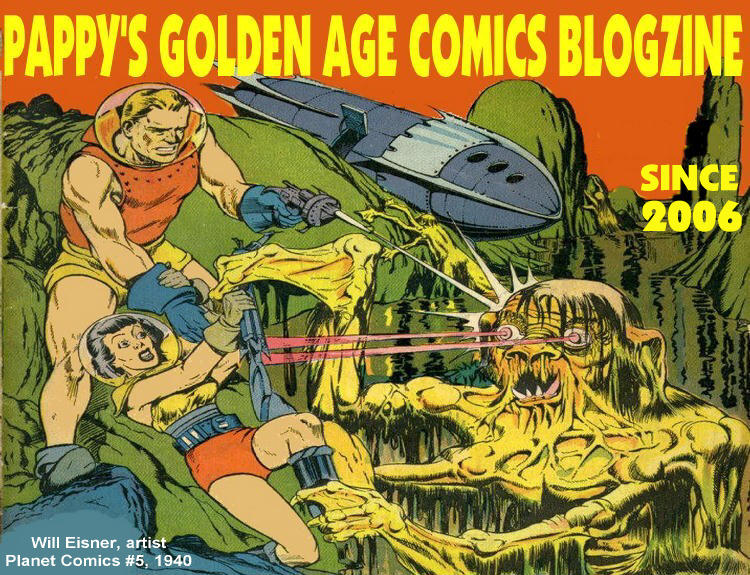The mad magician, man, he is really mad! He has a plan to cut someone in half and put them back together. The biggest and baddest magic trick of all. Too bad he can’t make it work. It seals the fate of at least one victim, a guy who came across the magician’s path, who we see chained to a wall pleading for his life. We are left to imagine his awful demise.
This tale, drawn by Harry Harrison and Wallace Wood for EC Comics’ Haunt of Fear #15 (actual issue #1, 1950), is from the very beginnings of the EC horror comics, and like others of its time, is feeling its way around what is really horror, or is just horrible. The plot of “The Mad Magician” is born of innumerable “shudder” pulps, and although well drawn, is hokey.
As you may know, Harry Harrison went into other endeavors after his comic book career, writing among them. He is well thought of for his science fiction work, including several popular novels. But he didn’t write this story. Fred von Bernewitz’s Complete EC Checklist credits it to Gardner Fox. Note the magician’s name of Boris Petaja. Emil Petaja was a well-known figure in science fiction circles, who also wrote several novels.
My scans for this story came from the Gladstone 1990 reprint from the double-sized first issue of The Vault of Horror, which includes a reprint of HOF #1.









5 comments:
The art on page one looks somewhat cartoony, not what you expect to see in a horror comic. Add to that the big title, "The MAD Magician," and it looks to me like a parody in MAD magazine! The story itself seems to be a horror parody: a magician keeps sawing people in half, hoping to find the one who will magically go back together again. I mean, what was "experimental" about this crazy endeavor? The way he cut the poor person each time? How was each try different? Sheesh. The worst part though is the fact that so much of the action happens off-panel, an unpardonable sin in comics. This is most definitely an early EC effort.
Ryan, with a few tweaks, yeah, this could have been a satire.
Since the magician is working under a delusion that at some point he will be able to make his trick work, that would be the definition of "mad," as in the title.
I felt the earliest comics we can identify as horror were very tame. I think the creators were kind of holding off to see what they could get away with. There had been the big flap over crime comics in '48, and in 1950 they might have felt under the gimlet eye of the censorious types watching comics. As it turned out, as the trend went on it got more and more graphic with the physical horror. So, if they had rewritten and redone this story a couple of years later they might have shown a dead person in two parts. That is, if it wasn't done as you suggest, a Mad satire.
Ryan anticipated me. Not so gory for an Ec comic, I guess they still had to find their right bloody own way to Horror.
I actually didn't know Harrison was an illustrator, and quite a good one (surely Wood's inking is a good help for everyone).
Before internet, my main source for informations 'bout comics were fanzines and the World Encyclopaedia of Comics by Maurice Horn (the italian version). Started reading it in 1979 and occasionally I still borrow it at my local library. No Harry Harrison there. Amazing how access to informations has widened.
P.S: America is full of medieval castles in horror comics... and this story takes place in Metropolis. Maybe Fox was tired of Gotham.
J D, well, sure, we have medieval castles in America. Robber barons of the 19th century bought up many European treasures. (San Simeon, William Randolph Hearst's castle in California, is full of them.) There are a lot of examples.
So, if you are in the market to sell the Leaning Tower, or anything by Michelangelo (the statue of David would look nice in some American billionaire's garden), let us know. We can handle it. After all, we bought London Bridge and moved it to Arizona!
As for World Encyclopedia of Comics, I read it years ago. I think there are a lot of omissions and errors, because the field of study into comics was still in its infancy. The studies really blossomed when it was realized that many of the original artists and writers of the early comics were getting old. Several history-minded individuals opened up a whole field of inquiry into comics. The people who launched the studies were wise; now those old-timers are indeed dead, and whatever memories they had that were left unspoken are sadly gone.
I don't agree with Ryan's final objection as stated. The problem is not that so much happens out-of-frame; it is that so much is revealed by the narration. If the unseen had instead been revealed by the seen, this story might have been more effective for showing so little.
Post a Comment